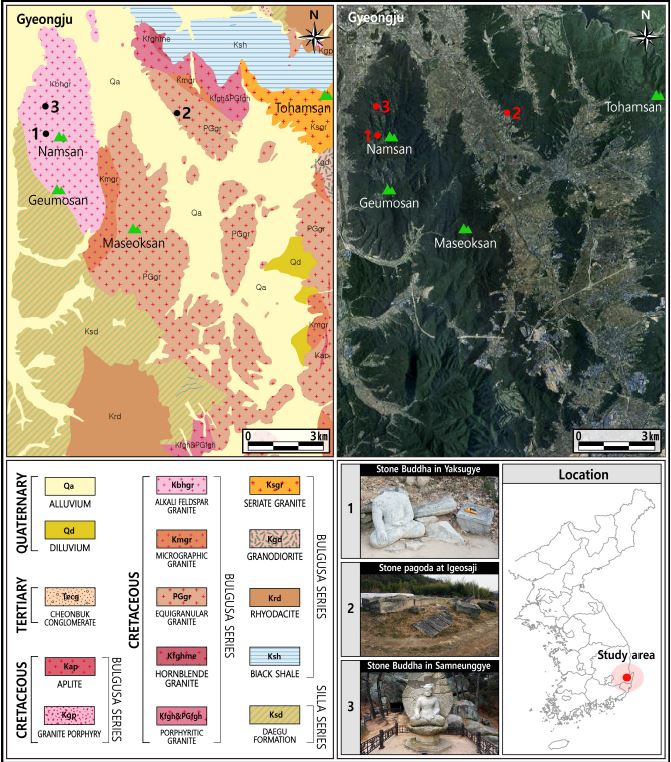
청와대 소재 경주 방형대좌 석조여래좌상의 암석학적 비파괴분석을 통한 산지해석
초록
청와대 소재 경주 방형대좌 석조여래좌상(일명 청와대 석불)의 원위치와 원형을 찾기 위해 암석학적 비파괴조사를 실시하였다. 청와대 석불좌상은 통일신라(9세기)의 대표적인 석불좌상이나 원래의 위치에 대해 의견이 다양하고 중대석과 하대석이 유실된 채 전해져 왔다. 육안조사, 전암대자율, 감마스펙트로미터 측정 등의 비파괴조사를 통해 석불을 구성하는 암석은 중립질 알칼리장석화강암으로 확인되었다. 석불좌상의 중대석이라 추정됐던 춘천박물관 소장 중대석은 세립 내지 중립질 담홍색화강암이고 비파괴분석 결과에서 다른 특성을 보여 석불좌상의 원래 중대석일 가능성이 낮아졌다. 석불좌상의 알칼리화강암은 경주 남산에서 광범위하게 확인되는 암석으로, 남산은 청와대 석불좌상의 암석산지로 추정된다. 석조여래좌상의 출처로 언급되는 경주 도지동이거사지와 경주 남산에는 청와대 석불좌상과 동일한 특징을 보이는 알칼리장석화강암이 노두와 동시기 석조유산에서 많이 확인되어 두 지역 모두 원래 봉안처로서 가능성이 있다.
Abstract
A nondestructive petrological investigation was carried out to identify the original location and form of the Gyeongju Seated Stone Buddha with Square Pedestals in the Blue House (so-called Stone Buddha in the Blue House). The Statue is a representative stone Buddha statue of Silla (9th century) but its original location is controversial and some parts were missing. Based on the petrological observation, magnetic susceptibility and gamma spectrometry, its stone material was identified as medium-grained alkali feldspar granite. This kind of granites are widely found in the Namsan, Gyeongju. It is very likely that the Namsan granites are the source of rock of the Stone Buddha. The Yudeoksa (Igeosaji temple site) and Namsan are possible to be the original home of the Buddha Statue since there are petrologically identical alkali feldspar granite outcrop distributed in Namsan and stone heritage made of the same stone type in both places. An investigation on the square middle stone base in the Chuncheon National Museum reveals that it is less likely to be the missing part of the Buddha statue as the stone base is fine-to medium-grained pink feldspar granite and has different magnetic susceptibility from the Buddha statue. This study confirmed the contribution and significance of petrological investigation to identification of stone heritage in Korea.
Keywords:
Seated Buddha in the Blue House, alkali feldspar granite, Gyeongju Namsan, magnetic susceptibility, gamma spectrometer키워드:
청와대 석불, 알칼리장석화강암, 경주 남산, 전암대자율, 감마스펙트로미터1. 서 론
경주 방형대좌 석조여래좌상은 청와대 경내 대통령 관저 뒤편에 위치하여 일명 ‘청와대 석불좌상’으로 불려왔으며, 1974년 1월 15일에 서울시 유형문화재 제24호 ‘석불좌상’으로 지정되어 보존관리 되어 오다가 근래에 가치를 새롭게 인정받아 2018년 4월 20일 보물 제1977호로 지정되었다(Cultural Heritage Administration, 2018). 이 불상은 1913년에 경주에서 서울로 옮겨져 1939년 조선총독부 관저가 현 청와대로 이전하면서 함께 이운되었다 전해진다(Cultural Heritage Administration, 2018). 석조여래좌상은 부처의 머리와 몸체가 온전한 통일신라 불교조각의 중요한 사례로 관심을 받아왔으나(Moon, 2018) 소재지가 청와대라는 특수성 때문에 그동안 접근이 어려워 본격적인 조사연구가 불가능했다.
석조여래좌상의 보물 지정에 앞서 역사·미술사적 가치를 검토하고 불상의 출처와 유실된 중대석의 원형을 검증하기 위해 학술조사가 실시되었다. 석조여래좌상은 경주에서 왔다고는 하나 정확한 출처에 대해 여러 설이 있으며(Moon, 2018), 유실된 중대석이 국립춘천박물관에 소장되어 있다고 전해지나(Lim, 2017)이 역시 검증이 필요한 상태였다. 이러한 문제들을 해결하는 실마리를 제공하고 과학적 근거자료를 확보하기 위해 석조여래좌상의 암석학적 비파괴조사와 산지해석을 실시하였다.
암석으로 이루어진 문화재의 산지를 과학적으로 규명하는 연구는 국내외에서 매우 활발하게 진행되어 이미 많은 연구자료가 축적되었고 연구방법론이 정립되어 가고 있다. 이 결과들은 옛 사람들의 석재이용에 대한 고고과학적 증거를 제시하고 잃어버린 원형을 찾는데 실마리를 제공할 뿐만 아니라 석조유산의 복원석재를 선택할 때 원형복원의 당위성을 부여하는데 중요한 역할을 하고 있다(Barba et al., 2009; Lee, C.H. et al., 2010a, 2010b; Lee, J.W. et al., 2010; Lee, M.S. et al., 2010, 2016; Kim, S.D. et al., 2011; Kim, J. et al., 2013; Al-Bashaireh and Dettman, 2015; Kim, S.W. et al., 2015; Park et al., 2015; Zoghlami et al., 2017).
석조여래좌상은 시료채취가 불가하여 비파괴조사방법만 제한적으로 사용하여 연구를 수행해야 했다. 따라서 암석기재적 특징, 전암대자율, 방사선량 등을 근거로 산지를 해석하였고, 옛 기록자료와 산지 주변에 산포하는 관련 석조유산의 암석조사를 병행하여 출처에 대한 개연성을 보강하였다. 이 결과는 석조여래좌상의 원형을 찾고 향후 복원석재 확보에 과학적 근거자료로 활용될 수 있다는 점에서 의미가 있다.
2. 현황 및 연구방법
2.1 위치 및 현황
경주 방형대좌 석조여래좌상은 본래 경주에 있었으나 1913년 경주금융조합 이사였던 오히라(小平)가 데라우치 마사타케(寺內正毅) 조선총독에게 바쳐 서울 남산 총독관저가 있던 왜성대로 옮겨졌다가 1939년에 총독관저가 경무대(현 청와대)로 옮겨지면서 현재의 위치로 이전되었다고 한다(Cultural Heritage Administration, 2018). 이에 지역사회 등 일각에서는 이 불상을 원래 있던 곳으로 되돌려 보내야 한다는 목소리가 있었으나 어느 사찰 또는 사찰터에서 이운했는지 알 수가 없어 난감한 상황에 처하기도 하였다.
현재 이 석조여래좌상은 중대석과 하대석이 유실되었지만 다른 부분은 큰 손상 없이 보존되어 있다(그림 1a). 통일신라 대표적 불상 손모양인 항마촉지인을 한 석가여래좌상으로, 사각의 연꽃문양대좌 위에 결가부좌 하였다. 석조여래좌상은 통일신라 8세기 불상의 특징인 당당한 어깨와 가슴을 지녔지만 두터운 팔과 손, 삼단사각대좌로 미루어 통일신라 후기인 9세기에 제작된 것으로 보고 있다. 현존하는 통일신라석불 중 머리와 몸체가 일체로 완전하게 갖추었을 뿐 아니라 연꽃모양을 새긴 사각형대좌는 동시기 불상 중에서 사례를 찾기 힘들다(Moon, 2018).

Full views of the Gyeongju Seated Stone Buddha with Square Pedestals in the Blue House (a) and middle stone base in the Chuncheon National Museum proposed for a missing part of the Buddha in the Blue House (b).
석조여래좌상의 주요 특징 중 하나는 대좌 전체가 사각형으로 만들어졌다는 것인데, 이는 경주 남산 약수계 항마촉지인 불상의 대좌와 아주 유사하다(Lim, 2017; Moon, 2018). 또한 현재 국립춘천박물관에 소장 중인 사각중대석이 도상의 배치 등에서 청와대 석조여래좌상과 일치하여 원래 이 석불상의 중 대석이라는 주장이 있었다(그림 1b; Lim, 2017; Moon, 2018).
2.2 조사 및 연구방법
경주 방형대좌 석조여래좌상의 암석학적 비파괴분석을 실시하기 위해 불신, 상대석, 중대석 암석에 대한 색상, 조직, 광물조성 등의 육안관찰에 의한 기재적 특징을 조사하고, 전암대자율과 방사선량을 측정하여 분석하였다. 또한 문헌을 조사하여 석불 이운 및 이와 연관된 기록을 탐색하여 석불의 원위치에 관한 정보를 수집하였다.
획득된 자료를 바탕으로 석재의 원산지로서 가능성이 있는 지역들에 대해 일차적으로 선행 연구된 자료를 통해 암석학적 및 전암대자율 정보를 획득하고 유력한 산지에 대해 야외 지질조사를 실시하였다. 암석의 육안적 특징을 기재하고 전암대자율과 감마스펙트로미터를 측정하여 석조여래입상 구성암석과 암석학적 특성을 비교하였다. 또한 향후 중대석과 하대석의 복원을 고려하여 추정산지 암석에 대해 편광현미경 및 X-선 회절분석을 실시하였다.
대자율 측정은 ZH Instruments 사의 SM30 모델을 사용하였고, 측정단위는 10-3 SI unit으로 표기하였다. 감마스펙트로미터는 GRM-260을 사용하였고 신뢰성을 확보하기 위해 한 지점에 대해 3분 간격으로 3회 측정하였다. 편광현미경은 자동계수기가 장착된 Nikon사의 LV100NPOL, X-선 회절분석기는 Panalytical EMPYREAN를 사용하였다. 주사된 X-선은 CuKα, 양극의 가속전압 및 필라멘트의 전류는 각각 40 kV, 100 mA이었다.
3. 석불의 암석학적 특징
경주 방형대좌 석조여래좌상은 불신과 상대석이 암색, 구성광물, 입자크기 등에서 거의 동일하다. 암석은 중립질 알칼리장석화강암으로써 먼지 등에 의해 전반적으로 연황색을 띠고 있으나 탈락된 부위의 신선한 표면은 명백히 유백색을 띤다(그림 2a, 2b). 조암광물은 중립의 알칼리장석, 석영, 사장석, 각섬석 등으로 구성되고 부분적으로 수 mm 크기의 정동과 염기성 미립 포획체가 특징적으로 확인된다(그림 2c). 국립춘천박물관 소장 중대석은 세립 내지 중립질 담홍색화강암으로 구성되어 있고(그림 2d), 홍색의 장석에 의해 전체적으로 엷게 붉은 색조를 띤다(그림 2e). 휴대용 현미경으로 표면을 관찰한 결과, 중대석은 세립 내지 중립의 석영, 정장석, 사장석, 흑운모 등으로 구성되어 있었다(그림 2f).
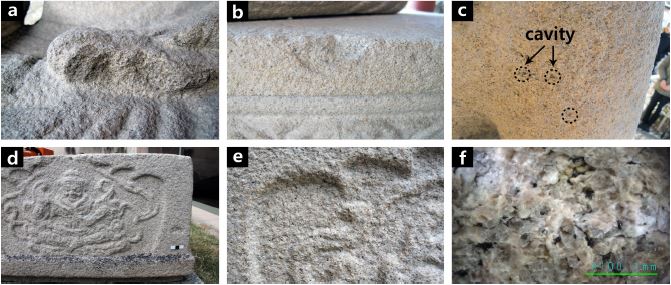
Petrological characteristics of the Buddha in the Blue House and the middle stone base in the Chuncheon National Museum. (a) Alkali feldspar granite of the Buddha body. (b) Alkali feldspar granite of upper stone base. (c) Cavities observed in the Buddha body. (d) Pink feldspar granite of the middle stone base in the Chuncheon National Museum. (e) Close view of the pink feldspar granite. (f) Fine-to medium-grained quartz, feldspar and biotite of the pink feldspar granite.
석불을 구성하는 암석의 재질특성을 파악하기 위해 휴대용 대자율 측정기와 감마스펙트로미터를 이용하여 암석의 자화강도와 방사선량을 측정하였다. 이 결과 석불은 0.27~2.51 (×10-3 SI unit)의 범위를 보이며 평균이 1.15 (×10-3 SI unit)로 산출되었고 상대석은 0.77~3.68 (×10-3 SI unit), 평균 2.18 (×10-3 SI unit)로써 석불보다 약간 높게 나타났으나 분포 양상에 전반적으로 유사성이 있다. 반면 중대석의 전암대자율은 4.43~6.72 (×10-3 SI unit)의 범위를 보이며 평균 5.61 (×10-3 SI unit)로 나타나 경주 방형대좌 석조여래좌상 구성암석들과 뚜렷한 차이를 보였다(그림 3a).
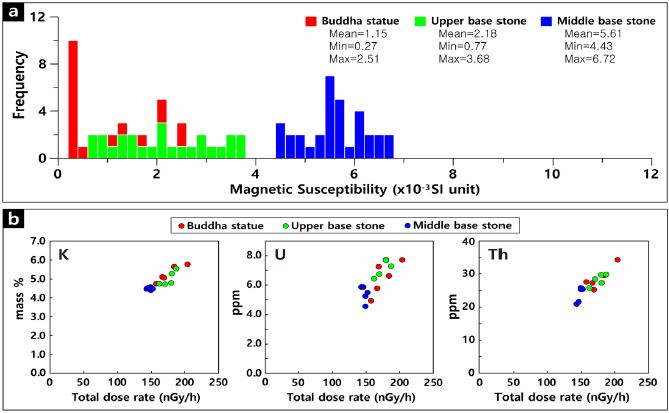
Magnetic susceptibility (a) and concentrations of potassium, uranium and thorium measured by gamma spectrometer (b) of the Buddha statue in the Blue House and the middle base stone in the Chuncheon National Museum.
감마스펙트로미터 측정 결과, 석조여래좌상 불신에서 K값은 4.72~5.74%, U값은 4.91~7.70 ppm, Th 값은 25.20~34.31 ppm 사이의 범위를 나타냈고 불신의 상대석에서 K값은 4.71~5.53%, U값은 6.42~7.70 ppm, Th값은 25.71~29.81 ppm 범위를 가진다. 반면 국립춘천박물관 소장 사각중대석은 K값 4.37~4.55%, U값 4.53~5.86 ppm, Th값 20.88~25.75 ppm를 보여준다(표 1; 그림 3b). 석조여래좌상의 불신과 상대석은 K, U, Th에서 각각의 값과 분포범위가 비슷하나 춘천박물관 사각중대석은 청와대 불상 구성석재보다 값이 다소 낮고 분포범위가 매우 좁아 균질한 특징을 보였다. 따라서 청와대 석조여래좌상 구성석재와 국립춘천박물관 사각중대석은 암석기재적 특징, 전암대자율, 감마스펙트로미터 측정 결과에서 모두 차이를 보임으로써 이들이 한 불상을 이루었을 가능성이 낮아졌다.
4. 석불의 산지해석
4.1 문헌기록과 산지탐색
이 석불좌상과 관련하여 조선고적도보 5권(1917년 간행)에는 석불좌상의 사진과 함께 “경주석조여래좌상(총독관저안치)”라는 제목이 달려서 경주에서 왔음을 지시하고 있다(그림 4a). 또한 매일신보기사(1934년 3월 29일자, 그림 4b), 오가와 게이치의 총독부박물관복명서(1938년 8월, 그림 4c), 경주박물관 경주고적조사보고서 등에 모두 ‘경주 석불상’으로 칭해지고 있어 이 불상이 경주에서 온 것은 분명한 사실인 것 같다.
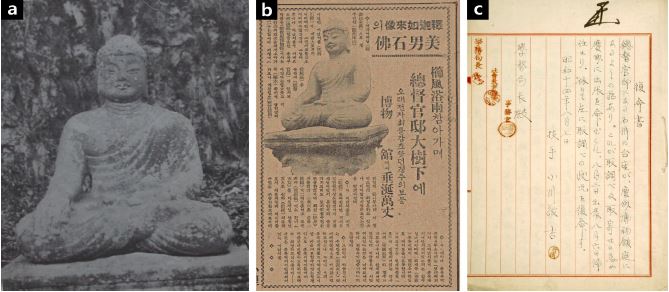
Old recordings of the Buddha statue in the Blue House. (a) Historic remains of Chosun published in 1917. (b) An article reported in Maeil Sinbo Newspaper (1934). (c) Museum Report written in 1938.
그러나 불상이 경주 어디에서 온 것인지 구체적인 장소에 대해서는 기록마다 다른 의견을 내놓고 있다. 조선고적도보에는 지역명을 언급하지 않았으나 경주 남산불상들과 함께 기재하여 남산과 관련 있는 듯 암시하였고, 매일신보 기사는 ‘현재 박물관 내로 옮겨진 경주 남산 약사여래좌상과 같은 골짜기(삼릉계)에 있던 불상’이라고 말하고 있다(Moon, 2018). 반면 총독부박물관복명서와 경주박물관 경주고적조사보고서에는 이 불상이 원래 있던 장소로 ‘유덕사’를 언급하고 있다(Moon, 2018). 또한 모로가 히사오가 집필한 ‘신라사적고(新羅寺蹟考)’ 도지리 이거사터 항목에도 ‘다이쇼 2년(1913년)에 석불좌상을 총독관저로 옮겼다’는 내용이 담겨 있다(Segye Ilbo, 2018). 유덕사는 경주 도지동에 있었다 전해지며 이거사지로 추정되는 사찰이다(Lim, 2017). 현재 이곳에는 석탑 부재들이 남아있다.
한편 경주 남산의 약수계에는 청와대 석조여래좌상과 형식 및 양식적 특징이 아주 유사한 약수계 석조여래좌상이 있다. 이 불상은 남성적이고 투박한 듯한 형태와 항마촉지인 손모양, 세부 조각수법, 그리고 사례가 드문 방형대좌를 가지고 있다는 점에서 유사하여 청와대 석조여래좌상과 같은 조각장 또는 같은 유파의 조각장이 조성했을 것이라 보고 있다(Moon, 2018). 이로써 경주 방형대좌 석조여래좌상의 출처에 대해 경주 남산 삼릉계, 약수계, 이거사지 모두 가능성을 염두에 두고 조사하였다.
먼저 조사지역의 암석분포를 살펴보았다. 경주지역의 화강암류는 광물조성의 차이로부터 각섬석흑운모화강섬록암, 흑운모화강암 그리고 알칼리화강암으로 분류되고(Lee et al., 1995), 기재적인 차이로부터 화강섬록암, 세리에이트 화강암, 반상화강암, 등립질화강암, 미문상화강암 및 알칼리화강암으로 구분된다(Lee and Hwang, 1999). 화강섬록암은 토함산, 흑운모화강암은 마석산을 중심으로 넓게 분포하고 있으며 알칼리화강암은 남산일대에 국한되어 소규모로 분포한다(그림 5).
선행연구에 의하면 감은사지 석탑을 제외한 많은 수의 경주 석조문화재는 알칼리장석화강암과 화강섬록암으로 만들어졌고 경주 남산(알칼리장석화강암)과 불국사 일대 토함산(화강섬록암)이 원료산지라 알려져 있다(Lee, S.H., 1996; Jwa et al., 2000, 2006; Lee, C.H. et al., 2004; Lee, M.S., 2007; Park et al., 2015). 청와대 석조여래좌상 역시 유백색 알칼리장석화강암으로 이루어져 있기 때문에 경주 남산이 유력한 산지로 추정된다.
4.2 추정산지의 암석학적 특징
경주 남산 삼릉계 일대 알칼리장석화강암은 우백질의 중립질 화강암으로 부분적으로 정동구조를 나타낸다(그림 6a, 6b). 정동은 수 mm 정도의 크기를 가지며 정동 내에는 석영, 형석 등을 자형으로 함유하고 있다. 주 구성광물은 알칼리장석, 석영, 흑운모, 각섬석 등이며, 사장석은 매우 소량으로 존재한다. 각섬석과 자철석의 함량은 변화가 심하여 하나의 노두에서도 매우 불균질하게 나타난다. 이곳의 화강암은 색상, 입자크기, 광물조성, 정동구조 등에서 청와대 석조여래좌상과 특징이 매우 유사하여 산지가능성이 높다.
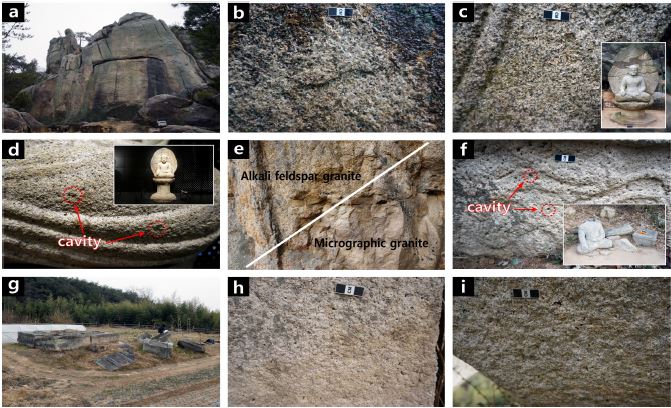
Petrological characteristics of alkali granite and microscopic granite found in Namsan area and Igeosaji temple site. (a) Alkali feldspar granite outcrop at the Samneunggye valley in the Namsan. (b) Close vies of the medium-grained alkali feldspar granite at the Samneunggye valley. (c) Samneunggye Seated Buddha Statue in Namsan (Treasure 666) made of alkali feldspar granite. (d) Samneunggye Seated Yaksa Buddha Statue from Namsan (stored in the National Museum) made of alkali feldspar granite. (e) Micrographic granite embedded in alkali feldspar outcrop at the Yaksugye valley in the Namsan. (f) Cavities developed in the fine-grained micrographic granite of the Yaksugye Seated Buddha Statue in Namsan. (g) Stone remains in the Igeosaji temple site Gyeongju. (h) Micrographic granite of the Stone Pagoda (basement) in the Igeosaji temple site. (i) Alkali feldspar granite of the Stone Pagoda (body) in the Igeosaji temple site.
삼릉계에는 수직·수평절리가 잘 발달된 알칼리장석화강암 암반이 곳곳에 있어 마애불이나 석불상과 같은 석조물을 조성하기에 최적의 환경을 갖추고 있다. 이곳에 소재한 경주 남산 삼릉계 석조여래좌상(보물 제666호)과 경주 남산 석조약사불좌상(국립중앙박물관 소장)도 동일한 특징을 보이는 알칼리장석화강암으로 조성되었다(그림 6c, 6d).
경주 남산 약수계 일대의 노두와 전석들도 대부분 알칼리장석화강암으로 이루어져 있고 부분적으로 미문상화강암이 확인된다(그림 6e). 이 화강암은 삼릉계의 알칼리장석화강암과 마찬가지로 정동이 발달하였고 중립질의 석영, 알칼리장석, 흑운모로 이루어져 청와대 석조여래좌상을 구성하는 알칼리장석화강암과 공통점이 많다.
약수계에는 청와대 석조여래좌상과 미술사적으로 동일한 형식과 양식을 보이는 경주 남산 약수계 석조여래좌상이 남아있다. 불상의 머리와 대좌 일부가 파손되었지만 전체적인 분위기와 방형대좌가 청와대 석조여래좌상과 공통점을 보여준다(그림 6f). 그러나 이 불상의 재질은 청와대 석조여래좌상과 다소 다르다. 구성암석은 수 mm~cm의 정동구조가 발달한 세립질 미문상화강암이다. 약수계 석조여래좌상 주변을 탐색한 결과 미문상화강암 노두를 확인할 수 있었으며 암면에 마애불입상이 조각되어 있었다(그림 6e).
청와대 석조여래좌상의 또 다른 출처라고 전해진 경주 유덕사(이거사지)를 조사하였다. 이곳은 지질도상 흑운모화강암이 분포하는 지역이나 이거사지 주변에서 노두를 확인하기 어렵다. 현재 이거사지 내에는 석탑 부재의 일부만 남아 있다(그림 6g). 이 부재들은 두 종류의 화강암이 혼용되었으며 기단부 석재는 정동구조가 발달한 미문상화강암(그림 6h), 탑신부 석재는 알칼리장석화강암으로 구성되어 있다(그림 6i).
청와대 석조여래좌상과 가장 유사한 특징을 보이는 경주 남산 알칼리장석화강암에 대해 시편을 채취하여 분석을 수행하였다. 박편을 제작하여 편광현미경으로 관찰해보면, 알칼리장석, 석영, 사장석, 흑운모, 각섬석 및 불투명광물로 구성되어 있고 반자형의 입상조직을 보인다. 석영은 대체로 타형으로 산출되고 알칼리장석과 문상조직을 보이며 알칼리장석은 조암광물 중에 가장 높은 함량을 보이면서 대부분 퍼사이트이다(그림 7a). X-선 회절분석 결과에서도 석영, 미사장석, 사장석 등의 광물조성을 보인다(그림 7b).
4.3 전암대자율과 감마스펙트로미터 비교
경주 남산 일대에 분포하는 알칼리장석화강암과 주변의 석조유산을 대상으로 전암대자율과 감마스펙트로미터 측정을 수행하였다. 전암대자율 측정 결과, 경주 남산의 알칼리장석화강암은 모든 조사대상에서 4.00 (×10-3 SI unit) 이하의 분포를 보이며 공통적으로 1.0 미만 낮은 값의 빈도가 높은 특징이 있다. 이는 청와대 석조여래좌상의 전암대자율 특징과 일치한다(그림 8a). 따라서 경주 남산의 삼릉계와 약수계 모두 청와대 석조여래좌상 구성암석의 산지로서 가능성이 있다.
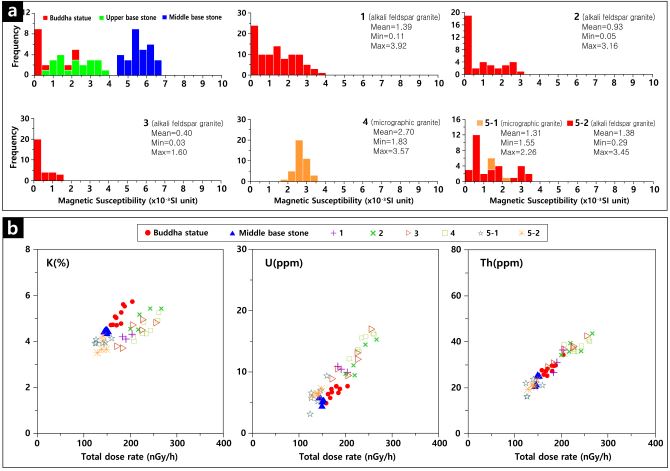
Magnetic susceptibility and gamma spectometric results for rock materials of the Buddha statue in the Blue House, Namsan and Igeosaji temple site. (a) Magnetic susceptibility. (b) Gamma spectrometry. 1; Alkali feldspar granite in Samneunggye,valley, 2; Seated Buddha in Samneunggye, Namsan (Treasure 666), 3; Seated Yaksa Buddha in Samneunggye (stored in National Museum), 4; Micrographic granite in Yaksugye valley, 5-1; Micrographic granite of Stone Pagoda (basement) in Igeosaji, Gyeongju, 5-2; Alkai feldspar granite of Stone Pagoda (body) in Igeosaji, Gyeongju.
감마스펙트로미터 측정 결과, 경주 남산의 알칼리장석화강암 노두와 알칼리장석화강암제 석조유산들은 K (%), U (ppm), Th (ppm)값에서 청와대 석조여래좌상보다 다소 광범위한 분포를 보여준다(표 2; 그림 8b). 청와대 석조여래좌상의 K값은 경주 남산 알칼리장석화강암의 영역에서 살짝 벗어난 분포를 제외하면 U와 Th의 검출농도는 모두 남산 화강암의 분포영역 내에 포함되고 있다. 따라서 전암대자율과 감마스펙트로미터 값의 비교를 통해 청와대 석조여래좌상과 경주 남산 일대의 알칼리장석화강암은 유사성이 인정된다.
5. 고찰 및 결론
청와대 소재 경주 방형대좌 석조여래좌상의 원형과 출처 파악을 위해 비파괴 재질분석 및 산지해석을 수행하였다. 청와대 석불좌상을 구성하는 암석은 0.27~3.68 (×10-3 SI unit)의 전암대자율(평균 1.62×10-3 SI unit)을 갖는 중립질 알칼리장석화강암인 반면 이 불상의 중대석이라 추정됐던 국립춘천박물관 소장 사각중대석은 4.43~6.72, 평균 5.61 (×10-3 SI unit)의 전암대자율 값을 보이는 세립 내지 중립질 담홍색화강암으로 확인되었다.
이 사각중대석은 사방에 신장상이 조각된 모양이 남산 약수계 석조여래좌상 중대석과 동일하고, 약수계 석조여래좌상은 형식과 양식에 있어 청와대 석조여래좌상과 매우 흡사하여 그간 미술사학계에서 청와대 석조여래좌상의 중대석이라는 견해가 매우 신빙성 있게 받아들여져 왔다(Lim, 2017; Moon, 2018). 그러나 암석학적 조사에 의해 양자가 서로 다른 암석임이 밝혀져 같은 불상일 가능성이 낮아졌다. 이에 문화재청이 청와대 석조여래좌상을 보물 지정할 시 춘천박물관 사각중대석은 제외되었다.
한편 암석기재적 특징, 전암대자율, 감마스펙트로미터를 이용한 비파괴분석에서 경주 남산의 알칼리
장석화강암이 청와대 석조여래좌상과 매우 유사한 특성을 보였다. 따라서 경주 남산이 이 석조여래좌상의 암석산지일 가능성이 매우 높다. 이 암석은 석조여래좌상의 출처라 언급되는 경주 이거사지 내 석탑의 일부 부재에도 사용되었고 경주 남산 삼릉계, 약수계 등지에 분포하는 석조문화재와 암석학적으로 동일하다.
이 연구를 통해 암석으로 이루어진 문화유산의 원형을 고증하고 산지를 찾는데 암석학적 연구의 역할과 필요성을 재확인할 수 있었다. 그러나 이번 조사에서 암석학적 조사결과와 인문학적 자료를 통합하여 종합적으로 해석함으로써 석불좌상에 대한 중요한 정보를 제공하고 원형을 찾는데 기여할 수 있었다.
Acknowledgments
이 논문은 문화재청 국립문화재연구소에서 수행한 국가지정 심의대상 문화재의 과학적 조사 결과를 보완하여 정리한 것이다. 다양한 관점에서 접근할 수 있도록 연구에 도움을 주신 문화재청 손영문 위원님, 황정연 선생님, 김은영 연구관님께 깊이 감사드린다.
REFERENCES
- Al-Bashaireh, K., and Dettman, D.L., (2015), Geochemical Analyses and Provenance Determination of White Marble Samples from Churches in North Jordan, Bulletin of the American Schools of Oriental Research, 374, p49-59.
-
Barba, L., Blancas, J., Manzanilla, L.Y., Ortiz, A., Barca, D., Crisci, G.M., Miriello, D., and Pecci, A., (2009), Provenance of the limestone used in Teotihuacan (Mexico) : a methodological approach, Archaeometry, 51, p525-545.
[https://doi.org/10.1111/j.1475-4754.2008.00430.x]

- Cultural Heritage Administration, (2018), National Cultural Heritage Portal, www.heritage.go.kr (October 30, 2018).
- Jwa, Y., Kim, K.K., Ko, S.B., and Kim, J.S., (2006), Source Area of the Rocks Using the West Stone Pagoda of Gameunsaji Temple Site, Korea, Journal of Petrology Society Korea, 15(3), p128-138, (in Korean with English abstract).
- Jwa, Y., Lee, S.W., Kim, J., and Sohn, D.W., (2000), Source area of stones used for the stone building of Bulguksa Temple and Seokguram Grotto, Journal of the Geological Society of Korea, 36, p335-340, (in Korean with English abstract).
-
Kim, J., Lee, M.S., and Lee, C.H., (2013), Petrological characteristics and provenance interpretation of Daejiguksatapbi (State Preceptor Daeji’s Memorial Stele) in Samcheonsaji Temple Site, Seoul, Economic and Environment Geology, 46, p93-104, (in Korean with English abstract).
[https://doi.org/10.9719/eeg.2013.46.2.93]

- Kim, S.D., Yi, J.E., Lee, D.S., and Lee, C.H., (2011), Homogeneity investigation of replace stone for restoration of the Mireuksaji stone pagoda in Iksan, Korea, Journal of Conservation Science, 27, p211-222, (in Korean with English abstract).
-
Kim, S.W., Hwang, G.H., Moon, S.W., and Jwa, Y.J., (2015), Petrological characteristics and provenance Estimation on the Stone Artefacts from the Pocheon Neulgeori Prehistoric Site, Korea, Journal of Petrology Society Korea, 24, p1-10, (in Korean with English abstract).
[https://doi.org/10.7854/jpsk.2015.24.1.1]

- Lee, C.H., Jeong, Y.S., and Joeng, M.H., (2004), Source Area and Petrological Characteristics of Rock Materials from the Namri Temple Site, Gyeongju, Korea, Cultural Heritage Science Technology, 3, p29-42, (in Korean with English abstract).
- Lee, C.H., Kim, J., and Lee, M.S., (2010a), Petrography and provenance interpretation of the stone moulds for bronze daggers from the Galdong prehistoric site, Republic of Korea, Archaeometry, 52, p31-44.
- Lee, C.H., Kim, M.Y., Jo, Y.H., and Lee, M.S., (2010b), Conservation treatment based on material characteristics, provenance presumption and deterioration diagnosis of the Seven-storied Jungwon Tappyeongri stone pagoda, Chungju, Korea, MUN HWA JAE, 43, p4-25, (in Korean with English abstract).
- Lee, J.D., and Hwang, B.H., (1999), Petrology of the granitoids in the Namsan-Tohamsan area around Gyeongju, Korea, Jornal of Korean Science Society, 20, p80-95, (in Korean with English abstract).
- Lee, J.W., Lee, M.S., Choi, Y.S., Oh, J.H., Kim, J.W., and Kim, S.D., (2010), Scientific conservation treatment and restoration of the Monument for Jo Heon and the Soldiers in Chilbaeguichong (Chilbaeguichong Jungbong joheonseonsaengilgunsunuibi), Journal of Conservation Science, 26, p191-201, (in Korean with English abstract).
- Lee, M.J., Lee, J.I., and Lee, M.S., (1995), Mineralogy and Major Element Geochemistry of A-type Alkali Granite in the Kyeongju Area, Korea, Journal of the Geological Society of Korea, 31, p583-607, (in Korean with English abstract).
- Lee, M.S., (2007), Assessment of Conservation Scientific Deterioration and Material Characteristics for Rock Properties of the Stone Pagodas in the Bulguksa Temple and Gameunsaji Temple Site, Gyeongju, Korea, Ph.D. thesis, Kongju National University, Kongju, p288, (in Korean with English abstract).
-
Lee, M.S., Chun, Y.G., and Kim, J., (2016), Study for selection of replica stone of the stele for Buddhist Monk Wonjong at Yeoju Godalsa temple site using magnetic susceptibility, Journal of Petrology Society Korea, 25, p299-310, (in Korean with English abstract).
[https://doi.org/10.7854/jpsk.2016.25.3.299]

- Lee, M.S., Han, M.S., Kim, J.H., and Kim, S.D., (2010), Material characteristics, provenance interpretation and deterioration diagnosis of Shilla Stone monuments in Jungseongri and Naengsuri, Pohang, MUN HWA JAE, Korean Journal of Cultural Heritage Studies, 43, p123-143, (in Korean with English abstract).
- Lee, S.H., (1996), Characteristics of the rocks and its weathering phenomena of the Gameunsa 3-story and Naweonri 5-story Pagodas located at the Kyeongju city, Korea, Journal of Conservation Science, 5, p20-40, (in Korean with English abstract).
- Lim, Y., (2017), History and meaning of the So-called “Buddha Statue at the Blue House”, Korean journal of art history, 296, p5-32, (in Korean with English abstract).
- Moon, M.D., (2018), A study on Gyeongju Banghyeon Pedestals, Hangmachokjiin Stone Seated Shakyamuni Buddha Statue Housed by the Blue House, The Art History Journal, 50, p265-273, (in Korean with English abstract).
-
Park, S.C., Moon, S.W., Kim, S.D., and Jwa, Y.J., (2015), A petrological study of stones used in the Three Storied Stone Pagoda of Bulguksa Temple, Journal of Petrology Society Korea, 24, p11-24, (in Korean with English abstract).
[https://doi.org/10.7854/jpsk.2015.24.1.11]

- Segye Ilbo, (2018), http://www.segye.com/newsView/20181016003794 (October 30, 2018).
-
Zoghlami, K., Diego Martín-Martínc, J.D., Gómez-Gras, D., Navarro, A., Parcerisa, D., and Roselle, J.R., (2017), The building stone of the Roman city of Dougga (Tunisia): Provenance, petrophysical characterisation and durability, Comptes Rendus Geoscience, 349, p402-411.
[https://doi.org/10.1016/j.crte.2017.09.017]



